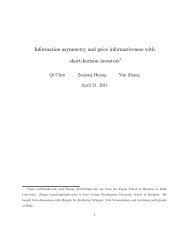Does Enforcement of Intellectual Property Rights Matter in China ...
Does Enforcement of Intellectual Property Rights Matter in China ...
Does Enforcement of Intellectual Property Rights Matter in China ...
Create successful ePaper yourself
Turn your PDF publications into a flip-book with our unique Google optimized e-Paper software.
<strong>of</strong> <strong>in</strong>formal f<strong>in</strong>anc<strong>in</strong>g ratio (8%) for the sample <strong>of</strong> Ch<strong>in</strong>ese firms <strong>in</strong> Ayyagari, Demirguc-Kunt, and<br />
Maksimovic (2010). The reason is that our sample firms are younger and have a higher sales growth<br />
than theirs. Annual sales growth <strong>of</strong> our samples are 134% (mean) and 18.3% (median) dur<strong>in</strong>g 2002-<br />
2005, while theirs are 13% (mean) dur<strong>in</strong>g 1999-2001. Firms <strong>in</strong> our sample, on average, have been<br />
<strong>in</strong> bus<strong>in</strong>ess for 7.8 years, while theirs are 16 years old. The higher <strong>in</strong>formal f<strong>in</strong>anc<strong>in</strong>g ratio <strong>in</strong> the<br />
younger firms is consistent with the suggestion by Allen et al. (2005) that “F<strong>in</strong>anc<strong>in</strong>g for private<br />
credit agencies (<strong>in</strong>formal f<strong>in</strong>ances), <strong>in</strong>stead <strong>of</strong> banks, is the most important channel dur<strong>in</strong>g a firm’s<br />
growth period (year 3-8)” (Page 95).<br />
Third, firm i <strong>in</strong> year t is coded as hav<strong>in</strong>g raised new external equity if the net <strong>in</strong>crease <strong>of</strong><br />
external equity for firm i <strong>in</strong> year t exceeds 5% <strong>of</strong> its total assets at the end <strong>of</strong> year t. Consistent with<br />
the def<strong>in</strong>ition <strong>of</strong> Baker, Ste<strong>in</strong> and Wurgler (2003), new external equity is equal to the net <strong>in</strong>crease <strong>in</strong><br />
book equity m<strong>in</strong>us the net <strong>in</strong>crease <strong>in</strong> reta<strong>in</strong>ed earn<strong>in</strong>gs. Only 18.4% <strong>of</strong> firm-year observations have<br />
recorded new external equity. 11<br />
Table 1 (Panel A) also reports the summary statistics for R&D <strong>in</strong>put and R&D output. We<br />
measure R&D <strong>in</strong>put as R&D <strong>in</strong>tensity, def<strong>in</strong>ed as R&D expenditures <strong>of</strong> firm i <strong>in</strong> year t divided by<br />
the start-<strong>of</strong>-year book assets. R&D <strong>in</strong>tensity averages at about 7.6% <strong>of</strong> assets and exhibits wide<br />
variation, with a standard deviation <strong>of</strong> 13.0%. R&D output for these high tech firms is measured as<br />
the number <strong>of</strong> <strong>in</strong>novation patents and the percentage <strong>of</strong> new product sales to total sales. The number<br />
<strong>of</strong> <strong>in</strong>novation patents has mean value <strong>of</strong> 0.81, with a standard deviation <strong>of</strong> 22.64. And the mean<br />
value <strong>of</strong> percentage <strong>of</strong> new product sales is 21.3%, with a standard deviation <strong>of</strong> 34.4%. 12<br />
11 S<strong>in</strong>ce our sample only <strong>in</strong>cludes unlisted companies, the companies ma<strong>in</strong>ly raise new equities from exist<strong>in</strong>g<br />
shareholders.<br />
12 292 observations are coded as miss<strong>in</strong>g, because these high tech firms have no reported sales.<br />
18



